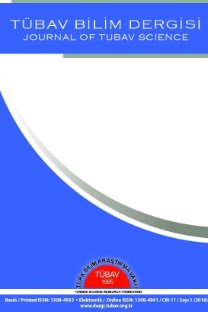Farklı Kompost Oranları İlave Edilmiş Kermes Meşesi Topraklarının Karbon Mineralizasyonu
Kompostlanmış tavuk gübresi mikroorganizmalar tarafından biyolojik olarak parçalanabilen bir organik maddedir. Mikroorganizmalar bu organik maddeyi ayrıştırırken CO2 ve inorganik maddelere dönüştürürler. Bu çalışmanın amacı aynı laboratuar koşulları altında (sabit nem, 28oC) üç farklı oranda steril ve steril olmayan kompostlanmış tavuk gübresi [(K=kompost, T=toprak), K+T1:6, K+T1:10 ve K+T1:12] ilavesinin kermes meşesi (Quercus coccifera L., Fagaceae) topraklarının karbon mineralizasyonunu nasıl etkilediğini belirlemektir. Tüm örneklerin karbon (C) mineralizasyonu 30 gün boyunca CO2 respirasyon yöntemiyle belirlenmiştir. Kumulatif C(CO2) değerleri tüm kompost denemelerinde inkübasyon süresiyle birlikte net olarak artmıştır. Bu artış hem 1:10 hem de 1:12 oranında steril ve steril olmayan kompost ilaveli toprak karışımında 1:6 oranında steril ve steril olmayan kompost ilaveli ve kompost ilavesiz topraktan anlamlı düzeyde daha yüksektir (P < 0.001). Bu sonuçlara göre, hem 1:10 hem de 1:12 kompost:toprak oranlarının mikroorganizmalar ve onların aktiviteleri için 1:6 oranlıya göre daha uygun toprak koşulları sağladığı sonucuna varmak mümkündür.
CARBON MINERALIZATION OF KERMES OAK SOILS ADDED TO THE DIFFERENT COMPOST RATES
Composted chicken manure is the organic matter that has been biologically decomposed by microorganisms. The microorganisms convert this organic matter into CO2 and inorganic matters. The aim of this study was to determine how carbon mineralization of kermes oak soil (Quercus coccifera L., Fagaceae) are affected by the addition of sterilized and unsterilized composted chicken manure at three different rates [(C=compost, S=soil), C+S1:6, C+S1:10 and C+S1:12] under the same laboratory conditions (constant moist at 28oC). Carbon (C) mineralization of all samples was determined by the CO2 respiration method during 30 days. Cumulative C(CO2) respired clearly increased with incubation time in all compost treatments. This increase was significantly higher in both 1:10 and 1:12 rates of unsterilized and sterilezed compost-soil mixtures than in 1:6 rate of unsterilized and sterilized compost-soil mixtures and soil with no added compost (P < 0.001 for all of them). According to these results, it is possible to conclude that both 1:10 and 1:12 of compost:soil rates provide more suitable soil conditions for microorganisms and their activities than 1:6.
